Easy Mango Jam Recipe is so simple and quick to make. Ripe creamy mangoes are ideal for making into a jam using lime juice and zest instead of adding pectin. Mango jam is vibrant, tropical, and tangy that can be served with toast, crepes, or scones.
Growing up, one of my fondest memories was spending summer at my grandmother’s house. On a sprawling estate, my cousins and I would spend long carefree hours in the hot Indian summer shaded by avenues of huge, overlapping trees. One of our perennial favorite hangouts was the mango grove. I still recall the convivial competitiveness of using hooks or sometimes even climbing trees to reach the ripest mangoes. These efforts frequently squelched our appetites, but I can still smell and taste the sticky, syrupy sweet pulp dribbling down my chin. As childhood memories go, these were some of my favorite idylls. Fast forward many years, I cannot believe how unbelievably lucky I was. The mango is as quintessential to my childhood as the hot Indian summers.
Origin of mango:
Interestingly, the mango is native to South Asia and is the national fruit of not only India but also the Philippines and Pakistan. While the wild mango is believed to have originated in the foothills of the Himalayas, the first recorded cultivation was around 5,000 years ago in Southern India. The mango rose to prominence through the successive generations of Indian rulers, especially the Moghuls, and went truly international in the late 15th century when the Portuguese landed on the west coast of India. Through the Colombian Exchange, the fruit emigrated through Europe to South America which is the principal source of mangoes for the US.
Interestingly, the mango is a drupe, which is a fleshy fruit covered by a thin skin and possessing a large pith (a central stone that contains the seed). That makes the mango, weirdly, distant relatives of olives, dates, and cherries, as well as the nutty family of cashews and pistachios which are also drupes. There are literally hundreds of mango varieties based on regional soil and climate characteristics as well as hybrids that are a cross-pollination within and without the mango family. There is even a hybrid where the mango was mated with a species of melon. What a far cry from the humble mango of my halcyon childhood!!
The mango is generally eaten raw, but for centuries, especially in the South, mangoes have been made into pickles and chutneys, both sweet and savory. In fact, one of the perennial favorite cooling summer dishes is to eat cold curd rice accompanied by a sour whole mango that has been embellished with salt and chili powder. Simple and yet so relevant to cool one down in the midst of a hot summer’s day.
The recipe below is not a savory. It is a sweet jam that I have been making ever since my visit to the Caribbean. While not common, you can find this jam in major grocery stores. My own history of making jams started with watching my mom make it, usually from fresh fruit before they started to go bad. Coming from a large household, we would sometimes overestimate the number of fruits we bought; so my mom turned the unused fruit into an easy Mango Jam using her own recipe.
What is pectin?
While everyone knows that we need to add sugar, one of the mysteries of jam-making is pectin. So, what is it and why is it used? Pectin is a starchy, soluble fiber (polysaccharide) that is mostly found in the skins of fruit. Its natural role is to act as a structural base that holds cell walls together. In this case, pectin helps suspend the small fruit slivers in a mesh that traps the liquid, effectively forming a gel. In order to form the gel, pectin needs two other components, acid, and sugar. While the acid extracts pectin from the fruit during simmering, sugar enhances the gel structure by absorbing the moisture from the pectin.
Some fruits such as apples, oranges, unripe grapes, certain berries, and lemons, are rich in natural pectin, while others such as cherries, melons, nectarines, and peaches are low in pectin. So, it is natural for us to combine high and low pectin fruits to make jam. This is why I have combined the mango (which is low in pectin) with lemon (high in pectin). While I can buy powdered pectin commercially, I love using natural ingredients in my recipes. The combination of the fruits allows me to explore flavors and express my creativity. While the combination of mango and lemon in a jam may seem counterintuitive, the recipe I have is truly friend and family favorite. Served alongside toast or scones, it adds a bright, cheerful, and tropical spin to an otherwise continental fare ~ just like the Caribbean.

How to make Mango Jam using my easy recipe:
1. Mix all the ingredients in a heavy-bottomed saucepan.
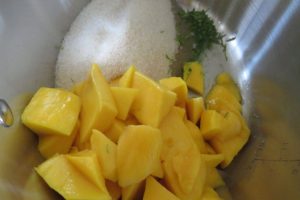
2. Bring to a boil, and then simmer for around 15 minutes. Stir occasionally.
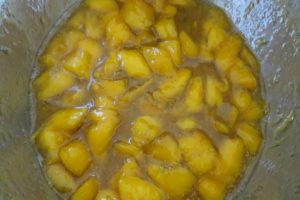
3. Cool the mixture and grind to a slightly coarse texture using a handheld blender.

4. Serve the mango jam with toast.
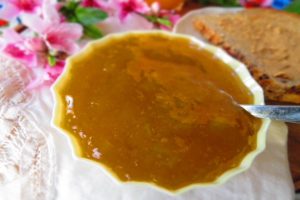
1. Creamy mangoes are perfect for making jams. Stringy mangoes must be chopped fine after removing the long strings.
2. Cool the jam completely before storing.
3. I have reduced the amount of sugar used in this recipe. Feel free to add more sugar if you like it sweeter.
4. Lemon juice and zest can also be used.
Suggestions to use this easy Mango Jam in the following recipes:
Storing:
This Easy Mango Jam using my recipe can be stored in an airtight container or mason jar and refrigerated for two months.
Easy Mango Jam Recipe
Equipment
- saucepan, hand blender
Ingredients
- 1½ cup ripe mango peeled, chopped
- ¾ cup sugar
- ¾ tbsp lime juice
- ½ tsp lime zest
- 1½ tsp filtered water
Instructions
Notes
- Creamy mangoes are ideal for making jam. Stringy mangoes must be chopped fine after removing long strings.
Nutrition


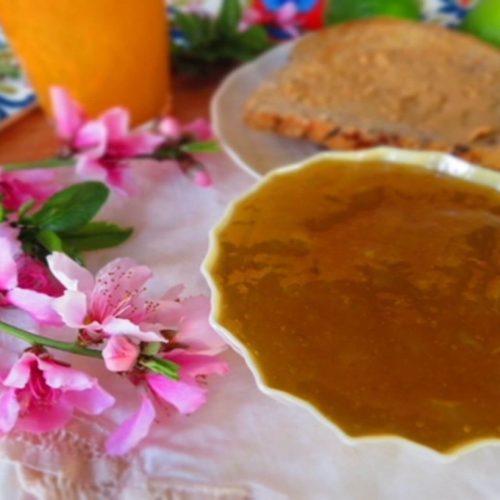
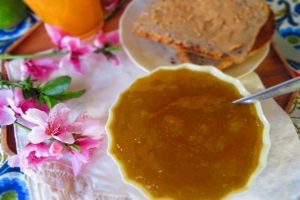




















so tasty!
Great work, Kanchan! I absolutely love your Caribbean recipes!
Thank you!